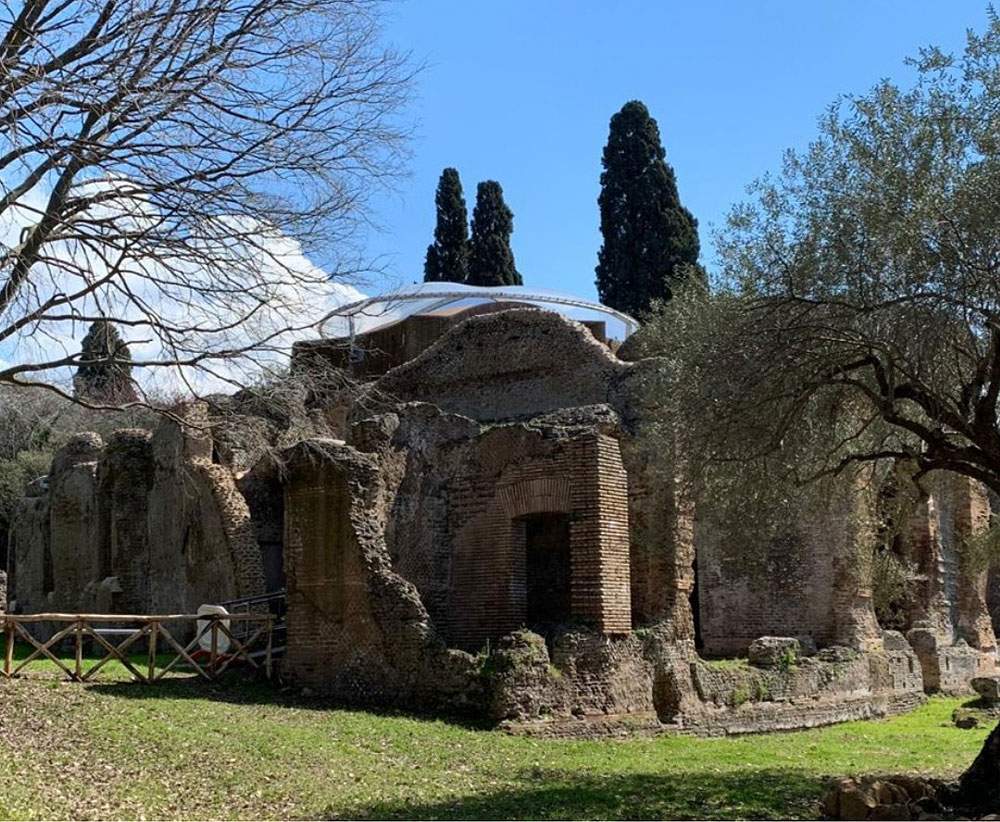TheVilla Adriana and Villa d’Este Institute - Villae officially reopens to the public on May 21, after restoration works conducted by the Regional Secretariat for Lazio, the Small Baths and the Hospitalia, two crucial areas of Hadrian’s Villa. These interventions are in addition to those on the Mouseia, recently reopened, thus promoting an expansion of access possibilities and the overall reinterpretation by scholars of the archaeological area of Hadrian’s Villa.
Declared a UNESCO World Heritage Site in 1999, the complex was built between 118 and 138 A.D. by Emperor Hadrian in a verdant, water-rich area near Tivoli, ancient Tibur. The villa, spread over an area of about one hundred and twenty hectares, presents a multipurpose architectural heritage, including residential structures, baths, nymphaeums, pavilions and gardens.
In the case of the Small Baths, the work involved the consolidation and recovery of the masonry, the cleaning of the pictorial and floor surfaces, and the refurbishment of the roofs, particularly for the Octagonal Hall; in addition to these interventions, the renovation of the didactic and communication apparatuses was carried out, as well as the setting up of an accessible visit route complete with tactile panels in Italian and English with transcription in Braille. The Small Baths constitute one of the most luxurious buildings in the complex: in addition to the variety of marble decorations, a significant wealth of architectural solutions can be seen in the plan of the different rooms, in the vaults and in the movement of curved and flat surfaces. Presumably the entire complex was used for imperial attendance, given also the proximity to complexes of similar purpose, such as the building with three exedras, the Nymphaeum-Stadium, and the building with fishpond.
The Hospitalia, on the other hand, were intended for middle-ranking personnel following the court, known especially for the black-and-white tile floor mosaics forming geometric and floral decorations. Here, too, cleaning, restoration, and remediation of the iron framing of the old interventions of the 1950s and 1960s have been carried out, including by detaching portions of the flooring, reintegrating gaps, and relocating the mosaic tiles in situ.
“Villa Adriana,” says Villae director Andrea Bruciati, “has belonged to the World Heritage List since 1999, as a masterpiece that uniquely brings together the highest forms of expression of material and artistic culture of the ancient world. The Small Baths are an innovative and experimental building that has provided interesting ideas for the expressive formulation of the Baroque and all those languages that possess an expanded nature: for this reason, too, they represent a seminal building for new cognitive visions, a sort of complex devoted to the metamorphosis of forms according to an almost organic layout, where the whole of the parts builds a holistic architecture in continuous movement. Therefore, our work is aimed at preserving this exceptional place, facilitating the possibility of accessing and enjoying it, and also promoting its reinterpretation on a daily basis, in the light of contemporary sensibilities.”
As noted by the MiC Regional Secretary for Lazio, Leonardo Nardella, head of the contracting station for the works, “the ’restoration action, favored by an exclusively public investment, has allowed the reinterpretation of this important heritage in a contemporary key, thanks to the use and experimentation of new techniques and innovative materials, light and performing and less invasive, unlike previous restorations, precisely for the preservation of those exceptional values that led to the identification of the UNESCO site of Villa Adriana. Prominent among all of them is the transparent ETFE dome with a lowered arch, which recreated an enclosed volume with minimal visual impact and without interfering with the ancient structures, allowing the Octagonal Hall to be protected from rainwater and further static disruption. During the works, which were followed and monitored by the single person in charge of the procedure, Dr. Benedetta Adembri, the director of works Enrico Calcara and Elsa Rizzi, with the coordination and testing of the Regional Secretariat for Lazio, important new scientific that have made it possible to expand the knowledge of Hadrian’s architecture, in particular of the dome of the Sala Ottagona, freed from the renovations of the 1960s, thus restoring to the building of the Small Baths their original physiognomy, distinct from the Great Baths of the archaeological district. Despite the setback imposed by the health emergency in 2020, the Contracting Authority effectively coordinated and concluded the work of upgrading and securing the masonry structures from the Hadrianic period and the tour route, which was completed last October by the company I.CO.RES srl, the main contractor awarded the contract with Consorzio ARKE’ and the Forcellino Company. Together with that of the museums and other cultural venues, the reopening of the Small Baths and Hospitalia, after a long lockdown period, marks a new phase of restart in the cultural world, with the hope that more new doors will be opened to the future.”
Ph.Credit Villa Adriana
 |
| Small Baths and Hospitalia of Hadrian's Villa in Tivoli accessible again after restoration |
Warning: the translation into English of the original Italian article was created using automatic tools. We undertake to review all articles, but we do not guarantee the total absence of inaccuracies in the translation due to the program. You can find the original by clicking on the ITA button. If you find any mistake,please contact us.